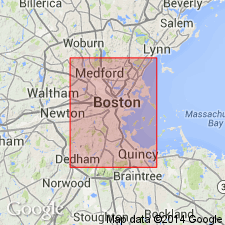
- Usage in publication:
-
- Cambridge slates
- Modifications:
-
- Original reference
- Dominant lithology:
-
- Slate
- AAPG geologic province:
-
- New England province
Summary:
Cambridge slates. Dense argillaceous material with little admixture of foreign substances. Thickness more than 200 feet. Best seen at Cambridge, Boston area, eastern Massachusetts]. Assumed to belong to same great series of beds as Roxbury conglomerate. Age is possibly primordial era [Cambrian].
[See also B.K. Emerson, 1917, USGS Bull. 597.]
Source: Publication; US geologic names lexicon (USGS Bull. 896, p. 322).
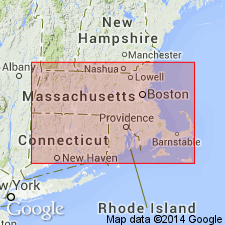
- Usage in publication:
-
- Cambridge slates
- Modifications:
-
- Areal extent
- AAPG geologic province:
-
- New England province
Summary:
Cambridge slates overlie Roxbury conglomerate and name is extended to other parts of the Boston basin where fossils similar to those found in vicinity of Mystic River have been found.
Source: GNU records (USGS DDS-6; Reston GNULEX).
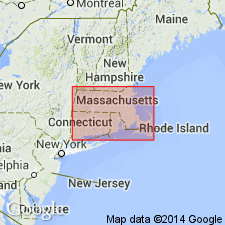
- Usage in publication:
-
- Cambridge slate*
- Modifications:
-
- Revised
- Age modified
- AAPG geologic province:
-
- New England province
Summary:
Cambridge slates revised to Cambridge slate. Age designated as Carboniferous.
Source: GNU records (USGS DDS-6; Reston GNULEX).
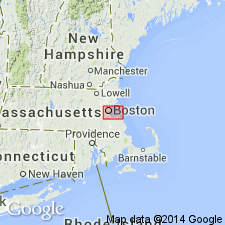
- Usage in publication:
-
- Cambridge argillite
- Modifications:
-
- Revised
- Age modified
- AAPG geologic province:
-
- New England province
Summary:
Revised name as Cambridge argillite [slate still good usage]. Unit does not include Tufts quartzite [as suggested by then unpublished report by LaForge in 1910; report was published in 1932 with Tufts as a member of the Cambridge]. Age revised to Permian.
Source: GNU records (USGS DDS-6; Reston GNULEX).
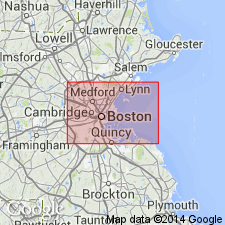
- Usage in publication:
-
- Cambridge slate*
- Modifications:
-
- Revised
- Age modified
- AAPG geologic province:
-
- New England province
Summary:
Cambridge slate assigned to the Boston Bay group and revised to include Tufts quartzite member. Tufts consists of 30 ft of greenish and white quartzite exposed on south slope of College Hill in Somerville, in a large quarry in East Everett, and on a half-tide island in the Mystic River. Uncertain whether the Tufts is the top of the Cambridge. Age of the Cambridge is revised as Devonian or Carboniferous. The rocks of the Boston Bay group cannot be correlated with any others in southeastern New England. Except for a few short pieces of tree trunks which cannot be identified with certainty but may be of either Devonian or Carboniferous age, the rocks contain no fossils. Age is also based on structural relations with adjacent rocks of other formations. [This report was originally prepared in 1910 and not published until 1932. In the interim, Billings (1929) removed the Tufts from the Cambridge and assigned both a Permian age. The revision was not incorporated in this report.]
Source: GNU records (USGS DDS-6; Reston GNULEX).
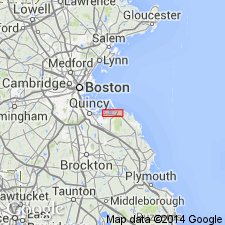
- Usage in publication:
-
- Cambridge argillite
- Modifications:
-
- Age modified
- AAPG geologic province:
-
- New England province
Summary:
Age revised as Carboniferous. Overlies Roxbury conglomerate, but Roxbury is thrust over Cambridge in northern part of Hingham area.
Source: GNU records (USGS DDS-6; Reston GNULEX).
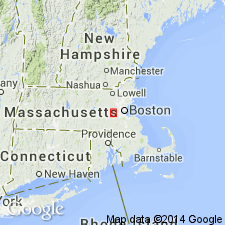
- Usage in publication:
-
- Cambridge Slate*
- Modifications:
-
- Age modified
- AAPG geologic province:
-
- New England province
Summary:
Age modified to Late Silurian and Carboniferous.
Source: GNU records (USGS DDS-6; Reston GNULEX).
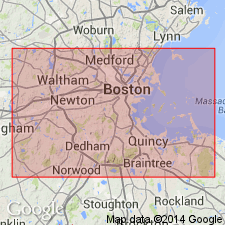
- Usage in publication:
-
- Cambridge Argillite
- Modifications:
-
- Revised
- Age modified
- AAPG geologic province:
-
- New England province
Summary:
Cambridge Argillite described as including "Milton Quartzite" (name used in quotes because the name Milton is already used for other New England rocks and a suitable alternative has not been chosen) and the Tufts Quartzite Member. Age of Boston Bay Group revised as Pennsylvanian or Permian based on fossils and regional relations. Fossil tree trunks in the group originally identified by LaForge (1932) as CORDAITES or LEPIDODENRON have been re-examined and could be CALIXYLON or CORDAITES. The rocks could not be dated better than Late Devonian through Permian on this basis. Regional relations indicate that the group is most likely Pennsylvanian or Permian.
Source: GNU records (USGS DDS-6; Reston GNULEX).
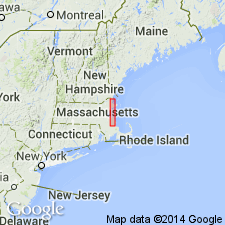
- Usage in publication:
-
- Cambridge Slate*
- Modifications:
-
- Age modified
- AAPG geologic province:
-
- New England province
Summary:
Age modified to Carboniferous.
Source: GNU records (USGS DDS-6; Reston GNULEX).
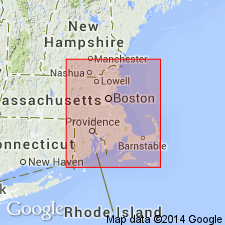
- Usage in publication:
-
- Cambridge Argillite*
- Modifications:
-
- Revised
- Age modified
- AAPG geologic province:
-
- New England province
Summary:
Name revised as Cambridge Argillite. Age changed to Proterozoic Z [Late Proterozoic] and possibly Early Cambrian. Boston Bay Group (including Cambridge Argillite) has been considered to be Pennsylvanian on the basis of now-discredited plant fossils and by correlation with rocks of Narragansett basin (Billings, 1976). Recent isotopic data of the Mattapan Volcanic Complex and field observations (Kaye and Zartman, 1980) indicate that Boston Bay rocks underlie fossiliferous Cambrian strata; thus the Boston Bay rocks may be as old as Proterozoic Z. In support of Kaye and Zartman's (1980) data, acritarchs of Proterozoic Z to Early Cambrian age have been identified in Cambridge Argillite (Lenk and others, 1982). [Authors state that Bedrock Geologic Map of Massachusetts will show Cambridge Argillite as Proterozoic Z or Paleozoic because it was compiled before the fossil discovery.]
Source: GNU records (USGS DDS-6; Reston GNULEX).

- Usage in publication:
-
- Cambridge Argillite*
- Modifications:
-
- Overview
- AAPG geologic province:
-
- New England province
Summary:
Used as Cambridge Argillite of Proterozoic Z to earliest Paleozoic age. Contains acritarchs.
Source: GNU records (USGS DDS-6; Reston GNULEX).
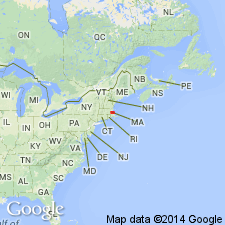
- Usage in publication:
-
- Cambridge Argillite
- Modifications:
-
- Not used
- AAPG geologic province:
-
- New England province
Summary:
Authors state, "...historic stratigraphy and stratigraphic units of the Boston basin are suspect." They suggest that the only formal nomenclature that should be retained is Boston Bay Group, undifferentiated, and perhaps the Weymouth Formation and the Braintree Argillite. Units within the Boston Bay Group--the Cambridge Argillite, and the Brookline, Dorchester, and Squantum (Tillite) Members of the Roxbury Conglomerate--were defined largely on the basis of the percentage of conglomerate, diamictite, argillite, sandstone, siltstone, tuff, and matrix present. Authors believe that recognition of these units in the field is nearly impossible and propose a facies-derived model for the Boston basin. They suggest that the Boston Bay Group was deposited in a submarine fan/slope/apron environment.
Source: GNU records (USGS DDS-6; Reston GNULEX).

- Usage in publication:
-
- Cambridge Argillite*
- Modifications:
-
- Age modified
- Biostratigraphic dating
- AAPG geologic province:
-
- New England province
Summary:
Cambridge Argillite of Boston Bay Group contains sandy horizons which are in some places quartzite. Most prominent are Milton quartzite unit of Billings (1976), and Tufts Quartzite Member (described by Billings, 1929, and LaForge, 1932) in northern part of basin. Red sandstone and sandy argillite in Chelsea, Revere, and Milton-Quincy areas intertongue with green argillite (Kaye, 1980). Red beds lie above cleaner quartzites such as Tufts and Milton units. Core analysis by D.A. Ashenden (Metropolitan District Commission, 1980, written commun.) indicates that Cambridge and Braintree Argillites are identical. Age of Boston Bay rocks has been controversial and was once thought to be Cambrian to Pennsylvanian (the latter based on lithologic similarity to rocks of Narragansett basin and now discredited plant fossils). Age of Cambridge and of Boston Bay Group as a whole is Proterozoic Z and possibly Early Cambrian based on presence of acritarchs in Cambridge. Acritarchs are diagnostic species that ranges in age from Proterozoic Z to Early Cambrian, but is most abundant in Proterozoic Z time (Lenk and others, 1982; [see also Goldsmith and others, 1982]). Age is also supported by the following: 1) plant fossils so numerous in strata of Narragansett basin are absent in the Boston Bay Group strata, 2) Late Ordovician and Early Silurian Quincy Granite contains argillite inclusions that are on strike with Cambridge Argillite, and 3) Boston Bay Group stratigraphy is primarily marine, not similar to terrestrial stratigraphy of Narragansett basin. Report contains geologic maps and correlation charts. [Chapters A-J in U.S. Geological Survey Professional Paper 1366 are intended as explanations and (or) revisions to 1:250,000-scale MA State bedrock geologic map of Zen and others (1983).]
Source: GNU records (USGS DDS-6; Reston GNULEX).
For more information, please contact Nancy Stamm, Geologic Names Committee Secretary.
Asterisk (*) indicates published by U.S. Geological Survey authors.
"No current usage" (†) implies that a name has been abandoned or has fallen into disuse. Former usage and, if known, replacement name given in parentheses ( ).
Slash (/) indicates name conflicts with nomenclatural guidelines (CSN, 1933; ACSN, 1961, 1970; NACSN, 1983, 2005, 2021). May be explained within brackets ([ ]).

